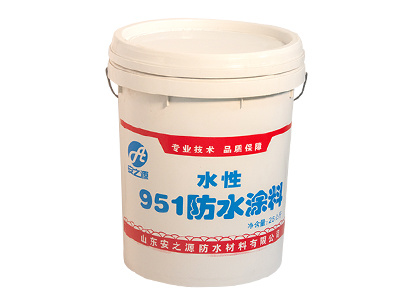Complete Analysis of Construction Technology for Reactive Adhesive Waterproof Rolls
Release time:
14 Nov,2022
Source:
Reactive adhesive waterproofing membrane is a new type of waterproofing material, which has advantages such as simple construction, good waterproofing performance, and environmental protection compared to similar materials. So, let's take a look at the complete analysis of the construction technology of reactive adhesive waterproofing membrane together!

Compared with ordinary waterproofing materials, reactive adhesive waterproofing membrane has the following characteristics.
1. Cold construction at room temperature without the need for hot melting. During construction, simply remove the isolation paper and paste it directly, making it extremely convenient and effectively shortening the construction period;
2. Having high tearing strength, it can effectively prevent stress damage to the waterproof system caused by cracking and deformation of the base layer;
3. Has extremely high permeability and impact resistance;
4. Excellent adhesion ensures the continuity and sealing of the coil seam;
5. High and low temperature, anti-aging, long-term effect
6. In terms of construction methods, the construction technology is complete, simple, highly operable, and has low labor intensity; Fast construction speed, high work efficiency, and can ensure the construction period; The construction quality is easy to ensure and can meet high waterproof requirements.
Process principle of reactive adhesive waterproofing membrane
Reactive adhesive waterproofing membrane is a type of waterproofing membrane that uses SBS and other elastomer asphalt as the substrate, polyethylene film, aluminum foil as the surface material, or no film (double-sided self-adhesive), and a release layer. Reactive adhesive waterproof membrane has strong bonding strength, and a specially designed rubber self-adhesive layer ensures the bonding and sealing between the membrane and the base layer, as well as between the membrane and the membrane, forming an overall sealed waterproof layer. It has excellent performance in acid alkali corrosion and other chemical media erosion. The surface of the reactive adhesive waterproof membrane has HDPE, which has high tear resistance and meets the requirements of puncture resistance. It can effectively prevent stress damage to the waterproof system caused by cracking and deformation of the base layer.
Process flow of reactive adhesive waterproofing membrane
1. Dry laying method
Grassroots cleaning, maintenance, and coating of supporting base treatment agent nodes, pasting and positioning, elastic base alignment adhesive waterproof roll pasting roller press, exhaust finishing, and overlapping organization inspection of protective layer construction.
2. Wet cloth method
Clean and wet the base layer (if this process is not required for base layer wetting), position, wire draw, mix and apply cement slurry, lay coiled materials for slurry discharge, exhaust, air dry, overlap, seal and wrap coiled materials, and conduct sealing inspection.
Key points of construction technology for reactive adhesive waterproofing membrane
1. The overall bonding sequence of the coil is as follows.
First high then low; At the same height, from far to near; On the same facade, start paving from high to low.
2. Underlay:
After the foundation surface is cleaned and accepted, the special foundation treatment agent shall be evenly applied to the foundation surface. The application shall be carried out in one direction, with a uniform thickness and no leakage or accumulation. It shall be dried until the fingers are not sticky.
3. Snap line, testing store:
Pop up the adhesive control line based on the actual overlapping area on the primer, strictly follow the adhesive control line and the actual adhesive coil, and ensure that the overlap width of the coil is 6-7cm (marked on the coil). Based on the characteristics of the site, determine the density of the spring line to make the coil stick straight and avoid skewing due to accumulated errors. The coil must be tested for position, accurately cut into the desired shape, and then begin actual pasting.
4. Node processing:
1) Finishing treatment of daughter wall: when making cement mortar, the internal corner at the junction of wall and roof must be painted with a small round corner with a radius of about 50mm. After the foundation surface meets the requirements, first apply a polyurethane waterproof layer. After evenly applying, immediately apply a matrix reinforcement layer (fiberglass), and then apply a second layer of polyurethane waterproof layer to firmly bond with the foundation surface. The construction of membrane bonding is also convenient.
2) Treatment of internal and external corners and pipe openings: The internal and external corners are rounded by 50mm with mortar, and a waterproof auxiliary layer is added. The auxiliary layer is equipped with a layer of glass cloth. At the junction of the nozzle and the base surface, after applying a leveling layer, reserve grooves, embed sealing materials, and remove rust and light around the pipeline. Install a waterproof additional layer within 500mm around the nozzle and add fiberglass cloth to achieve a comprehensive waterproof effect.
5. Large area coil laying;
There are two main methods for pasting large-area adhesive rolls: stretching and rolling. In actual construction, construction personnel can determine the pasting method based on the on-site environment, temperature, sunlight, and other conditions, but the basic requirements for exhaust, compaction, and wrinkle resistance are still the same.
1) Basic requirement: When pasting the coil, please always pay attention to the alignment with the reference line to avoid deviation and difficulty in correction. When laying the coil, do not use force to stretch the coil. After pasting, immediately use a roller to press from the middle of the roll to both sides, expel air, and ensure that the roll adheres firmly to the base layer, avoiding premature peeling of the isolation paper at the sticking area of the roll, contaminating the bonding layer, and mistakenly sticking.
2) Pulling method: Align the web plate with the reference line and unfold it to the entire width. Lift the web plate (each piece of isolation paper) from the edge, fold it in half along the centerline of the longer width of the web plate, and gently pull the edge of the isolation paper with a knife. Be careful not to scratch the web plate. Pull the isolation paper to the web plate first, and align the coil with half the length. Pull the peeled isolation paper evenly and forcefully backwards, and slowly pull out all the other half of the length of the isolation paper. Pay attention to the integrity of the extracted isolation paper. If any tears or fractures are found, immediately stop pulling, clean up the remaining torn isolation paper, and then continue pulling.
3) Drum method: that is, simultaneously tearing off the isolation paper and pasting the coil. During construction, there is no need to open the entire coil. Insert a steel pipe into the paper core cylinder in the center of the coil. Two people hold one end of the steel pipe and lift it to the beginning of the laying position. Show the coil forward about 500mm, and another person removes the isolation paper from this part of the coil. Wrap it around the used packaging paper core cylinder and gently arrange the coil with the isolation paper removed according to the pop-up baseline, firmly fixing it. After the paving of the starting end is completed, one person slowly removes the stripping paper, gets entangled in the above-mentioned paper core cylinder, and moves forward. The two people of the lifting coil roll forward along the reference line to apply the coil. Note that the movement speed of the two people lifting the coil is the same and very coordinated. When laying, it should not be too loose; After laying a coil, use a long handle roller brush to completely remove the air under the coil from the edge, and then use a large pressure roller or handheld light vibrator to compact the coil and stick it firmly.
4) Facade and large slope pavement: Self adhesive rolls are prone to sliding due to their relatively low adhesion to the base layer
5) After exhausting and compacting the large area coil, use a handheld small roller to compact the lap joint, and roll it outward from the inner edge of the lap joint to exhaust air and make it compact.
The above introduction is a complete analysis of the construction technology of reactive adhesive waterproofing membrane. If you need to learn more, please feel free to contact us at any time!


